A survey of hard spectrum ROSAT sources 2 optical identification of hard sources
- 格式:pdf
- 大小:313.53 KB
- 文档页数:10
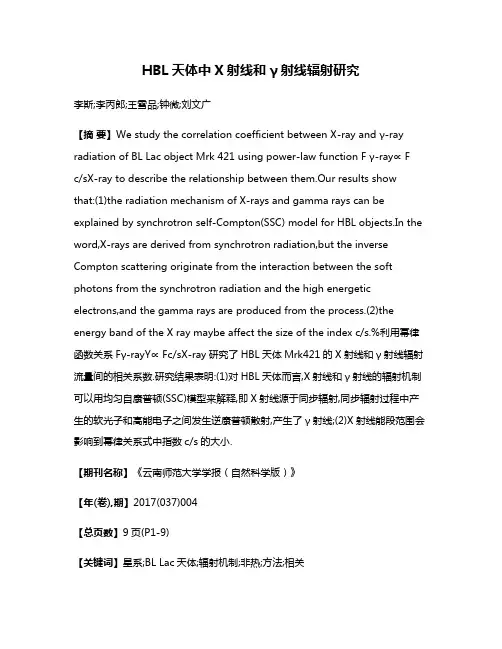
HBL天体中X射线和γ射线辐射研究李斯;李丙郎;王雪品;钟微;刘文广【摘要】We study the correlation coefficient between X-ray and γ-ray radiation of BL Lac object Mrk 421 using power-law function F γ-ray∝ F c/sX-ray to describe the relationship between them.Our results show that:(1)the radiation mechanism of X-rays and gamma rays can be explained by synchrotron self-Compton(SSC) model for HBL objects.In the word,X-rays are derived from synchrotron radiation,but the inverse Compton scattering originate from the interaction between the soft photons from the synchrotron radiation and the high energetic electrons,and the gamma rays are produced from the process.(2)the energy band of the X ray maybe affect the size of the index c/s.%利用幂律函数关系Fγ-rayY∝ Fc/sX-ray研究了HBL天体Mrk421的X射线和γ射线辐射流量间的相关系数.研究结果表明:(1)对HBL天体而言,X射线和γ射线的辐射机制可以用均匀自康普顿(SSC)模型来解释,即X射线源于同步辐射,同步辐射过程中产生的软光子和高能电子之间发生逆康普顿散射,产生了γ射线;(2)X射线能段范围会影响到幂律关系式中指数c/s的大小.【期刊名称】《云南师范大学学报(自然科学版)》【年(卷),期】2017(037)004【总页数】9页(P1-9)【关键词】星系;BL Lac天体;辐射机制;非热;方法;相关【作者】李斯;李丙郎;王雪品;钟微;刘文广【作者单位】云南师范大学物理与电子信息学院,云南省高校高能天体物理重点实验室,云南昆明650500;云南师范大学物理与电子信息学院,云南省高校高能天体物理重点实验室,云南昆明650500;云南师范大学物理与电子信息学院,云南省高校高能天体物理重点实验室,云南昆明650500;云南师范大学物理与电子信息学院,云南省高校高能天体物理重点实验室,云南昆明650500;云南师范大学物理与电子信息学院,云南省高校高能天体物理重点实验室,云南昆明650500【正文语种】中文【中图分类】P157.6BL Lac天体多波段能谱分布具有明显的双峰结构,低能峰位于光学波段到软X射线波段,而高能峰位于GeV到TeV区域[1].均匀同步自康普顿(SSC)模型能够较好地解释BL Lac天体的多波段能谱分布,在该模型中,低能峰由喷流内极端相对论性电子的同步辐射产生,而高能峰则由来自同一相对论性电子与同步辐射产生的软光子之间的逆康普顿散射(IC)产生,因此SSC模型认为产生X射线的电子与产生γ射线的电子是同源的.BL Lac天体根据低能峰(同步峰)的位置不同而分为低能峰BL Lac天体(Low-energy Peak BL Lacs,LBL)和高能峰BL Lac天体(High-energy Peak BL Lacs,HBL),LBL的同步峰主要位于光学波段,而HBL的同步峰主要位于紫外到X射线波段,因而研究HBL天体X射线波段和γ射线波段之间的相关性对于研究该类天体的辐射机制和物理过程有重要的意义.X射线和γ射线能段的观测[2-4]为两者流量同时性变化之间的相关性提供了直接的证据.1998年Mrk 421耀发活动的观测证明了X射线和γ射线之间存在紧密的相关性[5],证明了高能辐射的光子源于X射线耀发活动中产生的同步辐射软光子.Katarzyński等人[6]详细讨论了HBL天体Mrk 501的X射线辐射变化和TeV γ射线辐射变化之间的相关性,并且给出了一个简单的幂律函数来描述两者之间存在的关系.本文将采用他们对Mrk 501天体的研究思路,对Mrk 421天体X射线辐射变化和γ射线辐射变化之间的相关性进行详细的分析和讨论.均匀同步自康普顿(SSC)模型[6]常被作为HBL天体中X射线辐射和γ射线辐射的一种可能解释.Dermer等人[7-11]的研究工作表明SSC模型对全波段能谱分布(SED)中的X射线和γ射线的辐射机制能够给出较合理且简单的阐释.我们的目的是确定SSC模型是否可以解释光变观测到的具体特征.2.1 均匀同步自康普顿(SSC)模型均匀同步自康普顿(SSC)模型假设存在一个球形区域,且该区域无论处于膨胀状态还是压缩状态,它都是均匀分布的.为了简化物理模型、建立起描述该区域变化的数学表达式,只考虑该区域可能发生的四个基本物理过程:1)该球形区域体积的增加或减少;2)磁场强度的增强或减弱;3)粒子数密度的变化;4)粒子的加速或冷却.为了研究该区域内每个过程对辐射的影响,需要对每一个物理过程进行数学描述. 假设球形区域的半径为R,磁场强度为B.R和B随时间变化,这种变化可以用一个简单的幂律函数来表示:在(1)和(2)式中t0是初始时间, R0是初始区域半径, B0是初始磁场强度,指数re 和m都是自由参量.在初始时刻t0时,区域内电子能量分布可以用一个截断幂律函数来描述是电子洛伦兹因子(相当于电子的能量),描述的是截断的初始位置,n1是截断前的电子谱指数,n2是截断后的电子谱指数.在模型中我们假设X射线辐射和TeV γ射线辐射的主要成分均由电子能量为γbrk附近的电子产生.电子能谱的演化由下式的最小值决定其中的两个函数的具体表示如下:(5)和(6)式中,K1和K2指的是截断前后粒子数密度的变化,3rd是粒子数密度的增加或减少,粒子加速或冷却由指数ra(n1-1)或ra(n2-1)描述.如果假设的绝热膨胀或绝热压缩的区域内的粒子数密度是一个恒定的常数,那么参数re、ra和rd应该是相等的[12-13].为了分别研究上述过程的影响,需要给出详细的参数结果.电子的同步辐射系数由文献[14]确定,即(7)式中α=.因此,需要定义两个同步辐射系数,即表示低能电子辐射系数,即γ<γbrk;js2表示高能电子辐射系数,即γ>γbrk.忽略电子自吸收过程,因此可以估算出来自球形源的同步辐射强度,即可以求出同步辐射流量变化为(12)和(13)式中,s1是低能电子产生的同步辐射,s2是高能电子产生的同步辐射.以上两个流量之间的主要区别是辐射过程和磁场强度不同.2.2 逆康普顿散射IC自康普顿辐射又被称为逆康普顿散射(Inverse Compton scattering,简称IC). Tavecchio等人[15]用一个截断幂律谱详细研究了SSC辐射过程中的电子能谱.在他们的方法中,逆康普顿散射(IC)谱可以分为四个基本成分.而对于HBL天体,其中只有两个起主导作用的成分能产生自康普顿辐射,即:低能电子(K1,N1)和来自于同步辐射谱的第一部分(Is1,Fs1)共同作用而产生的F1,c,由高能电子(K2,N2)和来自于同步辐射谱的第一部分(Is1,Fs1)共同作用而产生的F2,c.因此,给出逆康普顿散射(IC)过程的主要辐射系数如下:通过类比同步辐射的推导过程,可以求出逆康普顿散射(IC)辐射强度为由此可估算出逆康普顿散射(IC)的流量值:其中c1描述的是在Thomson限制下的逆康普顿散射(IC)散射演化,c2描述的是在Klein-Nishina限制下的逆康普顿散射(IC)散射演化.为了研究HBL天体中X射线和γ射线之间的相关性,所选取的光变曲线必须满足以下条件[6]:1)X射线和γ射线的数据在同一时期内获得;2)两条光变曲线所选取的数据点的样本率相同,即在两条光变曲线上所选取的数据点的个数一致.在HBL天体中,时间变化的尺度非常短,可获得的数据点就比较多,因此光变曲线上的数据点也应该是比较密集的;3)额外的同时性能谱观测提供能谱演化的基本信息,例如,确定同步辐射产生的X射线Fs低于或者高于νFs(ν)峰.在实际的研究工作中,很难找到同时满足以上的所有条件的观测结果,仅在特殊情况下,X射线和γ射线的活动相关性可以被详细地研究和分析.图1展示了在2010年2月观测到的Mrk 421的光变活动.光变曲线分别是由Swift-XRT(0.5-2 keV)、RXTE-ASM(1.5-12 keV)、RXTE-PCA(2-20 keV)、Swift-BAT(15-50 keV)、Fermi-LAT(0.2-300 GeV)和HAGAR(>250 GeV)观测到的.其中X射线波段的光变曲线由Swift-XRT(0.5-2 keV)、RXTE-ASM(1.5-12 keV)、RXTE-PCA(2-20 keV)和Swift-BAT(15-50 keV)观测给出,γ射线波段的光变曲线由Fermi-LAT(0.2-300 GeV)和HAGAR(>250 GeV)观测给出.为了研究两者之间的相关性,需要对不同设备观测到的数据进行两两组合(如表1).观测数据在时间上是随机分布的,为了研究X射线波段和γ射线波段之间的相关性,需要对两个波段观测到的光变曲线进行比较,即选取在同一时段内两个波段同时性或者准同时性数据.但只按照这种方法进行,可能会出现如下情况:光变曲线上虽然有多个数据点,但是满足同时性或者准同时性的数据点相对较少.为了解决这一问题,可以在光变曲线中插入一个同时性的数据点,但注意这样做需要满足光变曲线有相似的采样,采样应该等于或者小于源的光变时间尺度特性变化.某些情况下光变曲线上的观测数据点之间存在着时间偏移,但由于这些数据点均为一天内的基本观测平均值,因此,采用插值法依然可以得到有效的结果.对(12)和(13)式进行对数处理,有对(17)、(18)式进行对数处理,得根据(19)、(20)、(21)、(22)式,得到关系式由(23)式可得在(24)式中,Fs(t)是同步辐射流量,其主要来源于SED图中同步辐射峰附近光子流量,即X射线流量,即FX-ray(t)≡Fs(t),Fc(t)是逆康普顿(IC)散射流量,其主要来源于SED图中IC峰附近光子流量,即γ射线流量,即有Fγ-ray(t)≡Fc(t).所以3.3 数据处理结果根据(23)、(24)、(25)式,对图1中Mrk 421天体光变曲线给出的X射线和γ射线辐射流量进行一元线性回归分析,分析结果如图2和表2所示.根据(23)式,在表2中自变量x表示logFs(t),因变量y表示logFc(t),线性关系的表达式为y=kx+b,其中k=c/s,b-er 是截距的误差范围的绝对值,k-er是斜率的误差范围的绝对值,N是数据点的个数,r为线性相关系数,p为置信度,SD为回归方程的标准偏差.由于k=c/s,根据(24)、(25)式,又可以得到如表3所示的结果.通过分析表2和表3中数据,可以得到以下结果:(1)图2(a)统计的logFXRT和logFLAT间呈现出显著的相关性,其相关系数为r=0.881 13,置信度P=0.020 35;图2(b)统计的logFASM和logFLAT之间也存在着显著的相关性,它的相关系数为r=0.767 62,置信度P=0.015 73;同样地,图2(c)、图2(d)分别统计的logFPCA和logFLAT、logFBAT和logFLAT的相关性也是特别显著的,其中图2(c)的相关系数为r=0.835 71,置信度P=0.019 19,图2(d)的相关系数为r=0.876 88,置信度P=0.004 25.(2)图2(e)、(f)、(g)、(h)中的统计结果分别表明logFXRT和logFHAG、logFASM和logFHAG、logFPCA和logFHAG、logFBAT和logFHAG之间呈现的相关性较弱,因为它们的相关系数r均小于0.5.(3) 当使用Swift-XRT(0.5-2 keV)和Fermi-LAT(0.2-300 GeV)观测时,得到的关系是用RXTE-ASM(1.5-12 keV) 和Fermi-LAT(0.2-300 GeV)观测时,得到的关系是用RXTE-PCA(2-20 keV) 和Fermi-LAT(0.2-300 GeV)观测时,得到的关系是用Swift-BAT(15-50 keV)和Fermi-LAT(0.2-300 GeV)观测时,得到的关系是用Swift-XRT(0.5-2 keV)、RXTE-ASM(1.5-12 keV)、RXTE-PCA(2-20 keV)、Swift-BAT(15-50 keV)探测到的X射线波段的辐射流量与用Fermi-LAT(0.2-300 GeV)观测到的γ射线波段的辐射流量之间存在着显著的相关性.这表明, HBL天体X射线和γ射线的辐射可以用均匀同步自康普顿(SSC)过程来描述,即X射线光子源于同步辐射,GeVγ光子产生于同源电子的逆康普顿散射.用Swift-XRT(0.5-2 keV)、RXTE-ASM(1.5-12 keV)、RXTE-PCA(2-20 keV)、Swift-BAT(15-50 keV)探测到的X射线波段的辐射流量与用HAGAR(E>250 GeV)观测到的γ射线波段的辐射流量之间没有相关性.对此做出如下解释:一般认为HAGAR探测到的γ射线的能量范围E>250 GeV,在这个能量范围以上产生的γ射线为次级γ射线,关于次级γ射线的产生,一种可能的解释是耀变体加速产生的高能宇宙线质子与河外背景光(EBL)光子、宇宙微波背景光(CMB)光子相互作用(pγ相互作用)产生了次级γ射线[17-19],或者高能光子之间作用产生的正负电子对可能通过逆康普顿散射过程散射微波背景光子,从而产生次级γ射线.如果采用简单的幂律公式来表示X射线和γ射线之间的关系,结合表3中的数据,X射线和γ射线的关系谱指数c/s≤1.Katarzyński等人[6]根据RXTE-PCA观测到的X射线辐射的光变曲线和用HEGRA观测到的TeV γ射线辐射的光变曲线,研究了两者的辐射流量之间的相关性,得到的结果是这个结果与我们的一致.但是我们研究的RXTE-PCA和Fermi-LAT 分别探测到的两条光变曲线的变化比Katarzyński等人用RXTE-PCA和HEGRA观测到的光变曲线的变化更好.根据表3给出的结果,发现X射线能段范围会影响到谱指数c/s的大小,即X射线能段范围不同,谱指数c/s也会不同.这个结论与Katarzyński等人[6]在研究Mrk 501天体时给出的结论是类似的,即相关性斜率可能依赖于谱带宽度.【相关文献】[1] URRY C M.BL Lac Objects and Blazars:Past,Present,and Future[J].ASP Conference series,1999,159:3-19.[2] BUCKLEY J H,AKERLOF C W,BILLER S,et al.Gamma-ray variability of the BL Lacertae object Markarian 421[J].The Astrophysical Journal Letters,1996,472(1):L9.[3] CATANESE M,BRADBURY S M,BRESLIN A C,et al.Multiwavelength observations of a flare from Markarian 501[J].The Astrophysical Journal Letters,1997,487(2):L143.[4] 李斯, 王艳芳, 龙光波,等. 费米耀变体多波段辐射流量相关性研究[J].云南师范大学学报:自然科学版,2015,35(6):1-7.[5] MARASCHI L,FOSSATI G,TAVECCHIO F,et al.Simultaneous X-Ray and TEV observations of a rapid flare from Markarian 421[J].The Astrophysical Journal Letters,1999,526(2):L81.[6] KATARZY SKI K, GHISELLINI G, TAVECCHIO F, et al. Correlation between the TeV and X-ray emission in high-energy peaked BL Lac objects[J].Astronomy &Astrophysics,2005,433(2):479-496.[7] DERMER,CHARLES D,SCHLICKEISER,et al.Model for the High-Energy Emission from Blazars[J]. Astrophysical Journal,1993,416(2):458-484.[8] BEDNAREK W,PROTHEROE R J.Testing the homogeneous synchrotron self Compton model for gamma ray production in Mrk 421[J].Monthly Notices of the Royal Astronomical Society,1997,292(3):646-650.[9] MASTICHIADIS A,KIRK J G.Variability in the synchrotron self-Compton model of blazar emission[J].Astronomy & Astrophysics,1997,320(1):19-25.[10]PIAN E,VACANTI G,TAGLIAFERRI G,et al.BeppoSAX Observations of Unprecedented Synchrotron Activity in the BL Lac Object Mkn 501[J].AstrophysicalJournal,1998,492(1):L17-L20.[11]KATARZY SKI K,SOL H,KUS A.The multifrequency emission of Mrk 501-From radio to TeV gamma-rays[J].Astronomy & Astrophysics,2001,367(3):809-825.[12]KARDASHEV N S.Nonstationarity of Spectra of Young Sources of Nonthermal Radio Emission[J].Soviet Astronomy,1962,6(12):317-327.[13]LONGAIR M S.Book-Review-High Energy Astrophysics-V.1-Particles Photons and TheirDetection-ED.2[J].Science,1992,257(5071):822-823.[14]RYBICKI G B,LIGHTMAN A P.Radiative processes in astrophysics[J].Weinheim:Wiley-VcH Verlag GmbH&Co.KGaA,2007.[15]TAVECCHIO F,MARASCHI L,GHISELLINI G.Constraints on the Physical Parameters of TeV Blazars[J].Astrophysical Journal,1998,509(2):608-619.[16]SHUKLA A,CHITNIS V R,VISHWANATH P R,et al.Multiwavelength study of the TeV blazar Mrk 421 during a giant flare[J].Astronomy & Astrophysics,2012,541(3):1053-1060.[17]ESSEY W,&KUSENKO A. A new interpretation of the gamma-ray observations of distant active galactic nuclei[J].Astropart. Phys.,2010,33(1):81-85.[18]ESSEY W,KALASHEV O E,KUSENKO A,et al.Secondary Photons and Neutrinos from Cosmic Rays Produced by Distant Blazars[J].Phys. Rev. Lett.,2010,104(14):141102.[19]ZHENG Y G,&KANG T.Evidence for secondary emission as the origin of hard spectra in TeV blazars[J].ApJ,2013,764(2):113-118.。
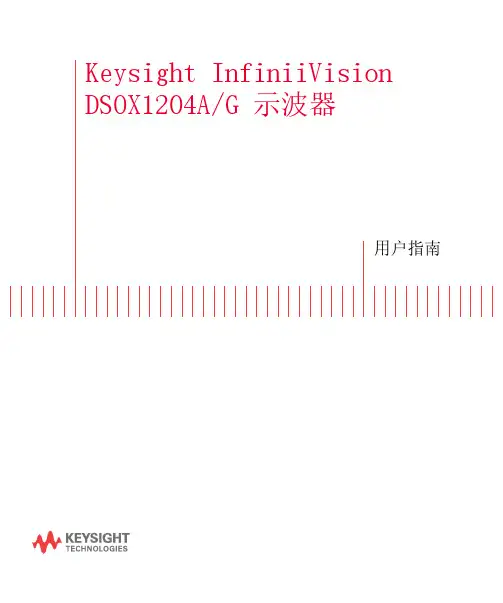
Keysight InfiniiVision DSOX1204A/G 示波器用户指南声明Keysight Technologies, Inc. 2005-2018根据美国和国际版权法,未经 Keysight Technologies, Inc. 事先同 意和书面允许,不得以任何形式或通过 任何方式(包括电子存储和检索或翻译 为其他国家或地区的语言)复制本手册 中的任何内容。
手册部件号N2137-97002版本第一版 版, 2018 年 9 月Malaysia 印刷发布者:Keysight Technologies, Inc.1900 Garden of the Gods Road Colorado Springs, CO 80907 USA修订历史N2137-97002, 2018 年 9 月担保本文档中包含的材料" 按现状"提供,在将来版本中如有更改,恕不另行通知。
此外,在适用法律允 许的最大范围内,Keysight 不对本手册及其包含的任何信息提供任何明示或暗示的保证,包括但不仅限于对适销性和用于特定用途时的适用性的暗示担保。
对于因提供、使用或运用本文档或其包含的任何信息所导致的错误或者意外或必然损害,Keysight 概不负责。
如果Keysight 和用户之间已达成的单独书面协议包含涉及本文档内容的担保条款,但担保条款与这些条款有冲突,则应以单独协议中的担保条款为准。
技术许可对于本文档中描述的硬件和/或软件,仅在得到许可的情况下才会提供,并且只能根据许可进行使用或复制。
美国政府的权利如美国联邦采购法规(以下称"FAR")第 2.101 条所定义,本软件是"商业计算机软件"。
根据 FAR 第 12.212条和第 27.405-3 条以及美国国防部FAR 补充条例(以下称"DFARS")第227.7202 条,美国政府采购商业计算机软件须与本软件按惯例向公众提供时一样适用相同的条款。
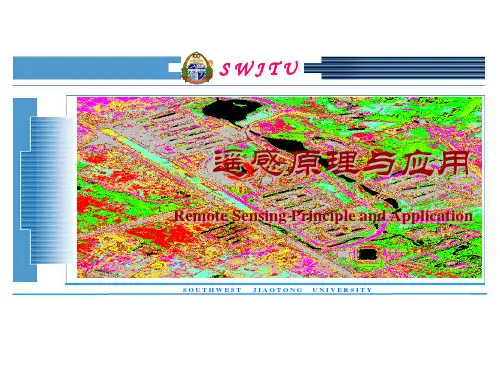

航天遥感专业英语(中英文对照)遥感remote sensing资源与环境遥感remote sensing of natural resources and environment 主动式遥感active remote sensing被动式遥感passive remote sensing多谱段遥感multispectral remote sensing多时相遥感multitemporal remote sensing红外遥感infrared remote sensing微波遥感microwave remote sensing太阳辐射波谱solar radiation spectrum大气窗atmospheric window大气透过率atmospheric transmissivity大气噪声atmospheric noise大气传输特性characteristic of atmospheric transmission波谱特征曲线spectrum character curve波谱响应曲线spectrum response curve波谱特征空间spectrum feature space波谱集群spectrum cluster红外波谱infrared spectrum反射波谱reflectance spectrum电磁波谱electro-magnetic spectrum功率谱power spectrum地物波谱特性object spectrum characteristic热辐射thermal radiation微波辐射microwave radiation数据获取data acquisition数据传输data transmission数据处理data processing地面接收站ground receiving station数字磁带digital tape模拟磁带analog tape计算机兼容磁带computer compatible tape,CCT高密度数字磁带high density digital tape,HDDT图象复原image restoration模糊影象fuzzy image卫星像片图satellite photo map红外图象infrared imagery热红外图象thermal infrared imagery,thermal IR imagery微波图象microwave imagery成象雷达imaging radar熵编码entropy coding冗余码redundant code冗余信息redundant information信息量contents of information信息提取information extraction月球轨道飞行器lunar orbiter空间实验室Spacelab航天飞机space shuttle陆地卫星Landsat海洋卫星Seasat测图卫星Mapsat立体卫星Stereosat礼炮号航天站Salyut space station联盟号宇宙飞船Soyuz spacecraftSPOT卫星SPOT satellite,systeme pro batoire d’observation de la terse(法)地球资源卫星earth resources technology satellite,ERTS环境探测卫星environmental survey satellite地球同步卫星geo-synchronous satellite太阳同步卫星sun-synchronous satellite卫星姿态satellite attitude遥感平台remote sensing platform主动式传感器active sensor被动式传感器passive sensor推扫式传感器push-broom sensor静态传感器static sensor动态传感器dynamic sensor光学传感器optical sensor微波传感器microwave remote sensor光电传感器photoelectric sensor辐射传感器radiation sensor星载传感器satellite-borne sensor机载传感器airborne sensor姿态测量传感器attitude-measuring sensor 探测器detector摄谱仪spectrograph航空摄谱仪aerial spectrograph波谱测定仪spectrometer地面摄谱仪terrestrial spectrograPh测距雷达range-only radar微波辐射计microwave radiometer红外辐射计infrared radiometer侧视雷达side-looking radar, SLR真实孔径雷达real-aperture radar合成孔径雷达synthetic aperture radar,SAR 专题测图传感器thematic mapper,TM 红外扫描仪infrared scanner多谱段扫描仪multispectral scanner.MSS 数字图象处理digital image processing光学图象处理optical image processing实时处理real-time processing地面实况ground truth几何校正geometric correction辐射校正radiometric correction数字滤波digital filtering图象几何配准geometric registration of imagery图象几何纠正geometric rectification of imagery 图象镶嵌image mosaic图象数字化image digitisation彩色合成仪additive colir viewer假彩色合成false color composite直接法纠正direct scheme of digital rectification间接法纠正indirect scheme of digital rectification 图象识别image recognition图象编码image coding彩色编码color coding多时相分析multitemporal analysis彩色坐标系color coordinate system图象分割image segmentation图象复合image overlaying图象描述image description二值图象binary image直方图均衡histogram equalization直方图规格化histogram specification图象变换image transformation彩色变换color transformation伪彩色pseudo-color假彩色false color主分量变换principal component transformation 阿达马变换Hadamard transformation沃尔什变换Walsh transformation比值变换ratio transformation生物量指标变换biomass index transformation 穗帽变换tesseled cap transformation参照数据reference data图象增强image enhancement边缘增强edge enhancement边缘检测edge detection反差增强contrast enhancement纹理增强texture enhancement比例增强ratio enhancement纹理分析texture analysis彩色增强color enhancement模式识别pattern recognition特征feature特征提取feature extraction特征选择feature selection特征编码feature coding距离判决函数distance decision function概率判决函数probability decision function模式分析pattern analysis分类器classifier监督分类supervised classification非监督分类unsupervised classification盒式分类法box classifier method模糊分类法fuzzy classifier method最大似然分类maximum likelihood classification 最小距离分类minimum distance classification 贝叶斯分类Bayesian classification机助分类computer-assisted classification 图象分析image analysis。
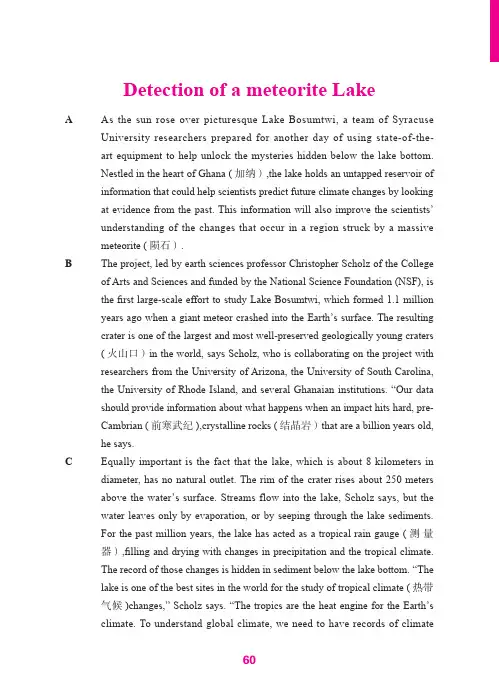
Detection of a meteorite LakeA A s the sun rose over picturesque Lake Bosumtwi, a team of SyracuseUniversity researchers prepared for another day of using state-of-the-art equipment to help unlock the mysteries hidden below the lake bottom.Nestled in the heart of Ghana (加纳),the lake holds an untapped reservoir of information that could help scientists predict future climate changes by looking at evidence from the past. This information will also improve the scientists’understanding of the changes that occur in a region struck by a massive meteorite (陨石).B T he project, led by earth sciences professor Christopher Scholz of the Collegeof Arts and Sciences and funded by the National Science Foundation (NSF), is the fi rst large-scale effort to study Lake Bosumtwi, which formed 1.1 million years ago when a giant meteor crashed into the Earth’s surface. The resulting crater is one of the largest and most well-preserved geologically young craters (火山口)in the world, says Scholz, who is collaborating on the project with researchers from the University of Arizona, the University of South Carolina, the University of Rhode Island, and several Ghanaian institutions. “Our data should provide information about what happens when an impact hits hard, pre-Cambrian (前寒武纪),crystalline rocks (结晶岩)that are a billion years old, he says.C E qually important is the fact that the lake, which is about 8 kilometers indiameter, has no natural outlet. The rim of the crater rises about 250 meters above the water’s surface. Streams flow into the lake, Scholz says, but the water leaves only by evaporation, or by seeping through the lake sediments.For the past million years, the lake has acted as a tropical rain gauge (测量器),fi lling and drying with changes in precipitation and the tropical climate.The record of those changes is hidden in sediment below the lake bottom. “The lake is one of the best sites in the world for the study of tropical climate (热带气候)changes,” Scholz says. “The tropics are the heat engine for the Earth’s climate. To understand global climate, we need to have records of climatechanges from many sites around the world, including the tropics.”D B efore the researchers could explore the lake’s subsurface, they needed aboat with a large, working deck area that could carry eight tons of scienti fi c equipment. The boat—dubbed R/V Kilindi—was built in Florida last year. It was constructed in modules that were dismantled, packed inside a shipping container, and reassembled over a 10-day period in late November and early December 1999 in the rural village of Abono, Ghana. The research team then spent the next two weeks testing the boat and equipment before returning to the United States for the holidays.E I n mid-January, fi ve members of the team—Keely Brooks, an earth sciencesgraduate student; Peter Cattaneo, a research analyst; and Kir am Lezzar, a postdoctoral scholar, all from SU; James McGill, a geophysical fi eld engineer;and Nick Peters, a Ph.D. student in geophysics from the University of Miami—returned to Abono to begin collecting data about the lake’s subsurface using a technique called seismic re fl ection pro fi ling. In this process, a high-pressure air gun is used to create small, pneumatic explosions in the water. The sound energy penetrates about 1,000 to 2,000meters into the lake’s subsurface beforebouncing back to the surface of the water.F T he reflected sound energy is detectedby underwater microphones—calledhydrophones—embedded in a 50-meter-long cable that is towed behind the boat asit crosses the lake in a carefully designedgrid pattern. On-board computers recordthe signals, and the resulting data are thenprocessed and analyzed in the laboratory.“The results will give us a good idea ofthe shape of the sediment are, and whenand where there were major changes insediment accumulation,” Scholz says. “Weare now developing three-dimensional perspective of the lake’s subsurface and the layers of sediment that have been laid down.”G T eam members spent about four weeks in Ghana collecting the data. Theyworked seven days a week, arriving at the lake just after sunrise. On a good day, when everything went as planned, the team could collect data and be back at the dock by early afternoon. Except for a few relatively minor adjustments, the equipment and the boat worked well. Problems that arose were primarily non-scientific— tree stumps, fishing nets, cultural barriers, and occasional misunderstandings with local villagers.H L ake Bosumtwi, the largest natural freshwater lake in the country, is sacred tothe Ashanti people, who believe their souls come to the lake to bid farewell to their god. The lake is also the primary source of fi sh for the 26 surrounding villages. Conventional canoes and boats are forbidden. Fishermen travel on the lake by fl oating on traditional planks (木板)they propel with small paddles (船桨).Before the research project could begin, Scholz and his Ghanaian counterparts had to secure special permission from tribal chiefs to put the R/V Kilindi on the lake.I W hen the team began gathering data, rumors (谣言)fl ew around the lake asto why the researchers were there. “Some thought we were dredging the lake for gold, others thought we were going to drain the lake or that we had bought the lake,” Cattaneo says. “But once the local people understood why we were there, they were very helpful.”Questions 14-18 .............................................................................Do the following statements agree with the information given in Reading Passage 1?In boxes 14-18 on your answer sheet, writeTRUE if the sataement agrees with the informationFALSE if the statement contradicts the informationNOT GIVEN if there is no information on this14W ith the analysis of the bottom of the lake, scientist will predict the climate changes in the future.15T he water stored in lake Bosumtwi was gone only by seeping through the lake sediments.16T he crater resulted from a meteorite impact is the largest and most preserved one in the world.17H istorical climate changes can be detected by the analysis of the sediment of the lake.18R esearch of scientist and co-workers had been interfered by the locals due to their indigenous believes.Questions 19-22 .............................................................................There are three steps of collecting data from the lake as followings, please filling the blanks in the Flow Chart below:Step 1a 50-meter 19 ,with many 20embededStep 2a 21 isneeded to create theexplosion into thewaterStep 3the 22enters deep intothe water andreturn backQuestions 23-27 ............................................................................. SummaryComplete the following summary of the paragraphs of Reading Passage, using no more than three words from the Reading Passage for each answer. Write your answers in boxes 23-27 on your answer sheet.The boat-double R/V Kilindi crossed the lake was dismantled and stored in a 23. The technology they used called 24; They created sound energy in to 1000-2000 metres in to the bottom of the lake, and used separate equipment to collect the returned waves. Then the data had been analyzed and processed in the 25. Scholz also added that they were now building 26view of the sediment or sub-image in the bottom of the lake. Whole set of equipment works well yet the ship should avoid tree stumps or 27fl oating on the surface of the Bosumtwi lake.。
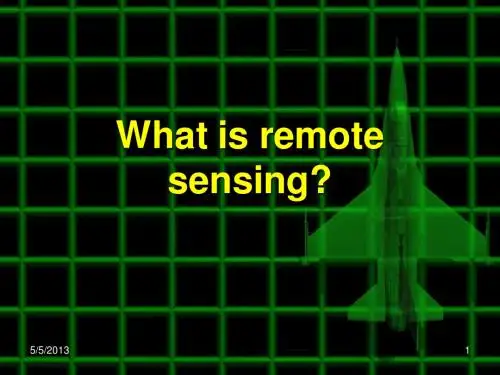
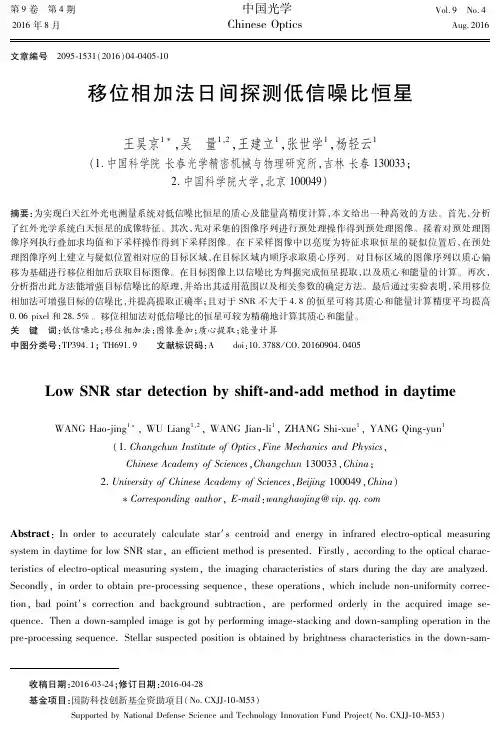
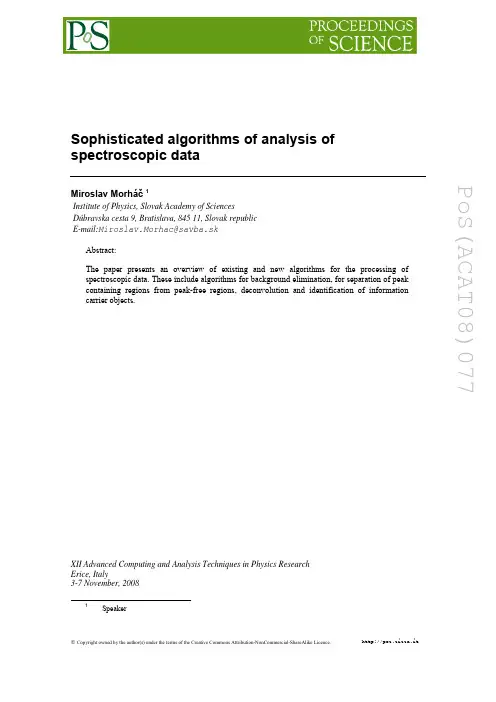
PoS(ACAT08)077Sophisticated algorithms of analysis of spectroscopic dataMiroslav Morháč 1Institute of Physics, Slovak Academy of SciencesDúbravska cesta 9, Bratislava, 845 11, Slovak republicE-mail:Miroslav.Morhac@savba.skAbstract:The paper presents an overview of existing and new algorithms for the processing of spectroscopic data. These include algorithms for background elimination, for separation of peak containing regions from peak-free regions, deconvolution and identification of information carrier objects.XII Advanced Computing and Analysis Techniques in Physics ResearchErice, Italy3-7 November, 2008 1SpeakerPoS(ACAT08)0771. IntroductionOne of the basic problems in the analysis of the spectra is the separation of useful information contained in peaks from the useless information (background, noise). In order to process data from numerous analyses accurately and reproducibly, the background approximation must be, as much as possible, free of user-adjustable parameters. Baseline removal, as the first preprocessing step of spectrometric data, critically influences subsequent analysis steps. The more accurately the background is estimated the more precisely we can estimate the existence of peaks. In the contribution we present an algorithm to determine peak regions and separate them from peak-free regions. Subsequently it allows to propose a baseline estimation method based on sensitive non-linear iterative peak clipping with automatic local adjusting of width of clipping window. One of the most delicate problems of any spectrometric method is that related to the extraction of the correct information out of the spectra sections, where due to the limited resolution of the equipment, the peaks as the main carrier of spectrometric information are overlapping. Conventional methods of peak searching based usually on spectrum convolution are inefficient and fail to separate overlapping peaks. The deconvolution methods can be successfully applied for the determination of positions and intensities of peaks and for the decomposition of multiplets.2. Background estimationAn accurate and fast method of background estimation, based on Statistics-sensitive Non-linear Iterative Peak-clipping algorithm (SNIP), has been developed in [1]. In [2] we extended the SNIP method for multidimensional spectra. In multidimensional spectra, the algorithm must be able to recognize not only continuous background but also to include all the combinations of coincidences of the background in some dimensions and the peaks in the other ones. In [3] we proposed several improvements of the SNIP algorithm. Further we have derived a set of modifications of the algorithm that allow estimation of specific shapes of background and ridges as well. Examples of one-, two-, and three-dimensional spectra before and after background elimination are given in Figs. 1-3.Fig. 1 An example of γ- ray spectrum with estimated background using decreasing clipping window and simultaneous smoothing .2PoS(ACAT08)0773Fig. 2 An example of two-dimensional γγ - ray spectrum before and after background elimination using the algorithm with simultaneous smoothing.Fig. 3 An example of three-dimensional γγγ - ray spectrum before and after background elimination using the algorithm with simultaneous smoothing.3. Estimation of peak regionsIn [4-5] the authors propose a peak-search method based on two-pass convolution of the spectrum with the first derivative of the Gaussian. Besides of the identification of peaks the method can be utilized for the determination of peaks intervals [6]. Based on this approach we proposed an improved background estimation algorithm with clipping window adaptive to peakregions widths. The comparison of both methods is presented in Fig. 4.Fig. 4 Experimental γ-ray spectrum with estimated background using fixed width of clipping window and width automatically adjustable to the widths of peak regions.PoS(ACAT08)0774. DeconvolutionThe peaks as the main carrier of spectrometric information are very frequently positioned close to each other. The extraction of the correct information out of the spectra sections, where due to the limited resolution of the equipment, signals coming from various sources are overlapping, is a very complicated problem. Deconvolution and restoration are the names given to the endeavor to improve the resolution of an experimental measurement by mathematically removing the smearing effects of an imperfect instrument, using its resolution function. As a rule deconvolution problems are very ill-conditioned, i.e., very small errors or noise in the deconvolved spectrum cause enormous oscillations in the resulting data. In the contribution we have studied only positive definite deconvolution algorithms (Gold [7], Richardson-Lucy [8],[9] and Maximum a posteriori [10]). In [11] we proposed boosted positive definite deconvolution algorithm. In [12] we developed deconvolution algorithm based on Tikhonov regularization of squares of negative values. Both allow to improve the resolution up to delta functions. Examples of one-, and two-dimensional spectra before and after deconvolution aregiven in Figs. 5 and 6, respectively.Fig. 5 Original and deconvolved γ-ray spectrum using classic and boosted Gold algorithm.Fig. 6 Original and deconvolved γγ-ray spectrum using boosted Gold algorithm.5. Identification of spectroscopic information carrier objectsIn [13] we proposed a peak searching algorithm based on convolution with the second derivative of Gaussian for multidimensional spectra. The algorithm is able to recognize crossing points of ridges of lower-fold coincidences from n-fold coincidence peaks (Fig. 7).4PoS(ACAT08)077 Fig. 7 Synthetic and experimental two-dimensional spectra with found peaks denoted by marks.In many cases in low-statistics spectra we need to smooth data before application of peaksearching algorithm. In [14] we proposed a smoothing and peak enhancement method based onMarkov chains. Again we generalized the method for multidimensional data. In Figs. 8 and 9we illustrate the smoothing and peak enhancement properties of the method.Fig. 8 Low-statistics γ-ray spectrum before and after application of Markov smoothing.Fig. 9 Low-statistics γγ-ray spectrum before and after application of Markov smoothing.In the spectra of nuclear multifragmentation one needs to determine ridges of correspondingpoints from very sparsely distributed two-dimensional experimental data. In [15] we proposedan algorithm based on linearization and smoothing using inverted positive second derivative of5PoS(ACAT08)077Gaussian. Application of Gold deconvolution allows decomposition of identified ridges to subridges. An illustrative example is presented in Figs. 10 and 11.Fig. 10 Original Si-Si spectrum and its detail.Fig. 11 Spectrum from Fig. 10 with determined ridges and decomposed to subridges.6. ConclusionsWe have generalized and extended the existing basic SNIP algorithm for additional parameters and possibilities that make it possible to improve substantially the quality of the background estimation. We have included these modifications and derived the algorithms for two-, three-, up to n-dimensional spectra.We proposed an algorithm for the determination of the peak regions. In the contribution we suggested an algorithm of background estimation with the clipping window adaptable to the widths of peak regions as well. Moreover the algorithm for separation of peaks containing regions from peak-free regions can be utilized for fitting purposes to confine the fitting regions.To improve resolution in spectra we analyzed a series of deconvolution methods. We proposed boosted deconvolution algorithms and the algorithm based on Tikhonov regularization of squares of negative values. Both algorithms are able to decompose the overlapped peaks practically to δ functions while concentrating the peak areas to one channel.Further in the contribution we present peak searching algorithm based on the second derivatives of Gaussian and peak searching algorithm for low-statistic spectra based on Markov chain method. The presented algorithms were implemented in DaqProVis system [16] and partially in ROOT system in form of TSpectrum classes[17].6PoS(ACAT08)077References[1] C. G. Ryan, E. Clayton, W.L. Griffin, S.H. Sie and D. R. Cousens, A statistics-sensitive backgroundtreatment for the quantitative analysis of PIXE spectra in geoscience applications, Nuclear Instruments and Methods B34 (1988) 396.[2] M. Morháč, J. Kliman, V. Matoušek, M. Veselský, and I. Turzo, Background elimination methodsfor multidimensional γ-ray spectra, Nuclear Instruments and Methods A401, (1997) 113.[3] M. Morháč and V. Matoušek, Peak clipping algorithms of background estimation in spectroscopicdata, Applied Spectroscopy 62, (2008) 91.[4] A. Likar and T. Vidmar, A peak-search method based on spectrum convolution, Journal of Physics.D: Applied Physics 36 (2003) 1903.[5] A. Likar, T. Vidmar and M. Lipoglavšek, Resolving double peaks in high-resolution spectra byspectrum convolution, Journal of Physics. D: Applied Physics 37 (2004) 932.[6] M. Morháč, An algorithm for determination of peak regions and baseline elimination inspectroscopic data, Nuclear Instruments and Methods A600, (2009) 478.[7] M. Morháč, J. Kliman, V. Matoušek, M. Veselský and I. Turzo, Efficient one and two dimensionalGold deconvolution and its application to gamma-ray spectra decomposition, Nuclear Instruments and Methods ., A 401 (1997) 385.[8] W.H. Richardson, Bayesian-based iterative method of image restoration, Journal of Optical Societyof America 62 (1972) 55.[9] L.B. Lucy, An iterative technique for the rectification of observed images, Astronomical Journal 79(1974) 745.[10] B. Hunt, Prospects for image restoration, International Journal of Modern Physics C5 (1994) 151.[11] M. Morháč, Deconvolution methods and their applications in the analysis of γ-ray spectra,Nuclear Instruments and Methods A559 (2006) 119.[12] M. Morháč and V. Matoušek, Complete positive deconvolution of spectrometric data, Digital SignalProcessing, Accepted for publication, 2008, doi 10.1016/j.dsp.2008.06.002.[13] M. Morháč, J. Kliman, V. Matoušek, M. Veselský, and I. Turzo, Identification of peaks inmultidimensional coincidence γ -ray spectra, Nuclear Instruments and Methods ., A 443 (2000) 108.[14] M. Morháč, Multidimensional peak searching algorithm for low-statistics nuclear spectra, NuclearInstruments and Methods A581 (2007) 821.[15] M. Morháč and M. Veselský, Identification of isotope lines in two-dimensional spectra of nuclearmultifragmentation., Nuclear Instruments and Methods ., A 592 (2008) 434.[16] M. Morháč, V. Matoušek, I. Turzo, and J. Kliman, DaqProVis, a toolkit for acquisition, interactiveanalysis, processing and visualization of multidimensional data, Nuclear Instruments and Methods A559 (2006) 76.[17] R. Brun, F. Rademakers, S. Panacek, D. Buskulic, J. Adamczewski, M. Hemberger, ROOT, AnObject-Oriented Data Analysis Framework, Users Guide 3.02c, CERN, 2002.7。

《星海求知:天文学的奥秘》期末考试及答案一、单选题(题数:50,共?50.0?分)1、各种寻找系外行星的方法中,“产量”最多的是()。
A、视向速度法B、凌星法C、直接成像法D、不清楚正确答案:B?2、银河系的中心方向主要位于哪个星座?()A、天琴B、天鹰C、人马D、天蝎正确答案:C?3、开普勒探测器使用的搜寻系外行星的方法是()。
A、视向速度法B、凌星法C、直接成像法D、微透镜法正确答案:B?4、黑洞、白洞和虫洞当中,目前可以视为已经有观测证据的是()。
A、黑洞B、白洞C、虫洞D、都没有正确答案:A?5、上弦月相对于朔月的日月角距变化了()度。
A、45B、90C、180D、270正确答案:B?6、“三起源”不包括()的起源问题。
B、天体C、生命D、人类正确答案:D?7、“不同历史时期宇宙膨胀速度不同”,这里“不同历史时期”相比于现代,几乎不会考虑()时期。
A、137亿年前B、50亿年前C、10亿年前D、旧石器时代正确答案:D?8、由于岁差原因,现在的黄道春分点已经位于()星座的位置。
A、白羊B、金牛C、双鱼正确答案:C?9、以下现象,不是由太阳活动导致的是()。
A、日冕物质喷射B、极光C、黑子D、太阳周年视运动正确答案:D?10、太阳系前五大卫星当中,质量与其所属行星质量最接近的是:()A、木卫三B、月球C、土卫六D、木卫四正确答案:B?11、宇宙标准模型中,时间是宇宙创生的()秒之后开始的。
A、10^(-4)B、10^(-10)C、10^(-36)D、10^(-44)正确答案:A?12、人类目前认识到的全部的宇宙物质,占全部宇宙物质的份额接近()。
A、.05B、.25C、.5D、1正确答案:A?13、大爆炸模型在()年代正式确立为标准宇宙模型。
A、1930年代-1940年代B、1940年代-1950年代C、1970年代-1980年代D、1980年代-1990年代正确答案:C?14、以下生物组合与“动物-植物-真菌-原核生物-原生生物”的分类顺序不一致的是()。
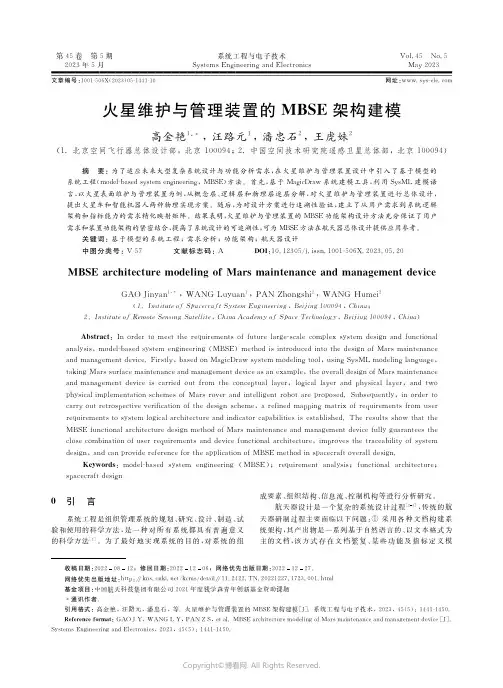
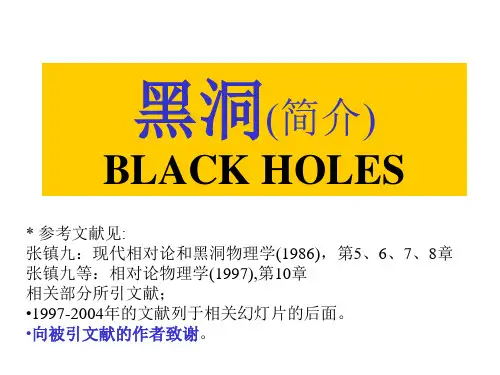
钱德拉太空望远镜引言美国航空航天局的钱德拉X射线天文台,这是由哥伦比亚号航天飞机发射和部署 1999年7月23日,是最先进的X射线天文台建立。
钱德拉被设计来观察X射线从高能量的区域的宇宙, 是迄今为止人类建造的最为先进、也最为复杂的太空望远镜,被誉为“X射线领域内的哈勃”。
摘要钱德拉X射线太空望远镜是为了观察来自宇宙最热的区域的X射线而设计的,先进的成像系统ACIS,由两个额外的科学仪器提供的X-射线的的能量,LETG 和HETG光谱仪的详细信息,以及望远镜的操作和任务数据。
主要内容钱德拉望远镜是美国航宇局NASA“大天文台”系列空间天文观测卫星中的第三颗。
该系列共由4颗卫星组成,其中康普顿(Compton)伽马射线观测台和哈勃太空望远镜(HST)已分别在1990和1991年发射升空,另一颗卫星称为太空红外望远镜设施(SIRTF),也就是斯皮策太空望远镜,于2003年发射成功。
在轨道上运行的光学望远镜哈勃太空望远镜观测可见光,而在另一轨道上的“钱德拉”则捕捉X射线。
钱德拉X射线太空望远镜是为了观察来自宇宙最热的区域的X射线而设计的。
与可见光的光子相比,X射线更具能量,而且就像子弹一样能够穿透光学望远镜所使用的抛物面镜。
但是当它掠过镜子表面的时候就会像子弹一样改变方向。
为此,钱德拉X射线太空望远镜有4副镜子(4个抛物面镜,4个双曲面镜),这些镜子像“漏斗”一样把X光集中到高性质照相机内。
镜子的制作精度达到了空前的高度:光学系统的两端间的距离是2.7米,误差为1.3×10-6米(一根头发丝的1/5)。
钱德拉X射线太空望远镜上面的仪器在测量X射线的能量的同时还能够担出高清晰度的照片。
另外,瞄准系统的精度也非常高,能够瞄准1公里以外的鸡蛋大小的物体,误差为3毫米。
钱德拉望远镜的造价高达15.5亿美元之巨,加上航天飞机发射和在轨运行费用,项目总成本高达28亿美元。
它是迄今为止人类建造的最为先进、也最为复杂的太空望远镜,被誉为“X射线领域内的哈勃”。
2024年无线电工程第54卷第1期121 doi:10.3969/j.issn.1003-3106.2024.01.016引用格式:赵艳敏,南洪涛,董超,等.基于SVM模型的星载GNSS R内陆水体识别方法研究[J].无线电工程,2024,54(1):121-128.[ZHAOYanmin,NANHongtao,DONGChao,etal.ResearchonInlandWaterBodyRecognitionMethodBasedonSVMModelforSpaceborneGNSS R[J].RadioEngineering,2024,54(1):121-128.]基于SVM模型的星载GNSS R内陆水体识别方法研究赵艳敏1,南洪涛2,董 超1,孙 波1,(1.山东农业大学信息科学与工程学院,山东泰安271018;2.中国空间技术研究院载人航天总体部,北京100094)摘 要:内陆水体探测是遥感领域中的重要研究方向之一,涵盖河流形态变化监测、实时洪水监测和地表水变化分析等领域。
支持向量机(SupportVectorMachine,SVM)在非线性分类问题上表现优秀并且能够得到较低的错误率。
提出了一种基于SVM的全球导航卫星系统反射(GNSS R)信号内陆水体识别方法,使用星载GNSS R信噪比(SignaltoNoiseRatio,SNR)作为像素构建遥感图像,并应用合成少数类过采样技术(SyntheticMinorityOversamplingTechnique,SMOTE)进行数据处理。
在此基础上,通过SVM模型的方式实现水体信息提取,并在刚果盆地区域的旋风全球导航卫星系统(CycloneGlobalNavigationSatelliteSystem,CYGNSS)数据进行了验证。
结果表明,未进行SMOTE算法处理的分类准确率是65.1%,其中水体分类准确率5.39%,而经过SVM模型和SMOTE算法处理后,数据分类准确率提高至96.49%,水体分类准确率提高至96.32%,准确率和水体查准率都得到了提高,显示了利用基于SVM的星载GNSS R内陆水体识别方法的有效性。
arXiv:astro-ph/0103055v1 3 Mar 2001Mon.Not.R.Astron.Soc.000,000–000(0000)Printed1February2008(MNLATEXstylefilev1.4)ASurveyofhardspectrumROSATsources2:opticalidentificationofhardsources
M.J.Page1,J.P.D.Mittaz1,F.J.Carrera1,21MullardSpaceScienceLaboratory,UniversityCollegeLondon,HolmburyStMary,Dorking,SurreyRH56NT,UK.
2InstitutodeF´ısicadeCantabria(ConsejoSuperiordeInvestigacionesCient´ıficas–UniversidaddeCantabria),39005Santander,Spain.
ABSTRACTWehavesurveyed188ROSATPSPCfieldsforX–raysourceswithhardspectra(α<0.5);suchsourcesmustbemajorcontributorstotheX–raybackgroundatfaintfluxes.Inthispaperwepresentopticalidentificationsfor62ofthesesources:28AGNwhichshowbroadlinesintheiropticalspectra(BLAGN),13narrowemissionlinegalaxies(NELGs),5galaxieswithnovisibleemissionlines,8clustersand8Galacticstars.TheBLAGN,NELGsandgalaxieshavesimilardistributionsofX–rayfluxandspectra.TheirROSATspectraareconsistentwiththeirbeingAGNobscuredbycolumnsof20.5distributionofX–raytoopticalratioswhichissimilartothatfoundforAGNfromsoftX–raysurveys(1oftheBLAGN,NELGsandgalaxiesareradioloud.ThiscouldbebecausetheradiojetsintheseobjectsproduceintrinsicallyhardX–rayemission,oriftheirhardnessisduetoabsorption,itcouldbebecauseradioloudobjectsaremoreX–rayluminousthanradioquietobjects.The8hardsourcesidentifiedasclustersofgalaxiesarethebrightest,andsoftestgroupofsourcesandhenceclustersareunlikelytobeanimportantcomponentofthehard,faintpopulation.WeproposethatBLAGNarelikelytoconstituteasignificantfractionofthefaint,hard,0.5-2keVpopulationandcouldbeimportanttoreproducingtheshapeoftheX–raybackground,becausetheyarethemostnumeroustypeofobjectinoursample(comprisingalmosthalftheidentifiedsources),andbecauseallourhighredshift(z>1)identifiedhardsourceshavebroadlines.
1INTRODUCTIONTheoriginofmostoftheX–rayemissionintheUni-verseisstillunknownbecausethesourcesthatproducemostofthe>2keVX–raybackground(XRB)arestilltoberesolved.ROSATsurveyshavesucceededinresolv-ing∼80%ofthe1-2keVXRBintoindividualsources(Hasingeretal.1998),andopticalidentificationandX–rayspectroscopyhasbeenpossibleforbrightersourceswhichproduce∼40%ofthe1-2keVbackground.ThemajorityofthesesourcesarebroadlineAGN(hereafterBLAGN),andatfaintfluxesnarrowemissionlinegalaxies(hereafterNELGs,McHardyetal.1998);Schmidtetal.(1998)arguedthattheNELGsarealsoAGN,butwithlowluminosityorobscuredbroadlineregions.Onaver-age,faintNELGshaveharderX–rayspectra(fν∝ν−α
withα∼0.5,Romero-Colmeneroetal.1996,Almainietal.1996)thanthebroadlineAGNwhichhavemeanα∼1(Mittazetal.1999,Ciliegietal.1994).DespitethesuccessofROSATsurveys,theXRBcan-notbesynthesisedbyextrapolatingtheobservedsourcepopulationstofaintfluxes,becausetheresultantspec-trumwouldbesofterthanthatofthebackground;this
discrepancyispresentforallenergybandsbetween0.5and40keV.Thismeansthatatfaintfluxestheremustbeapopulationofsourceswithspectrathatareharderthanthebackground.Accordingtoleadingmodels,thesehardsources(egFabian1999,Gilli,Risaliti&Salvati1999)areobscuredAGN.However,thephysicalnatureandobserva-tionalappearanceoftheXRBproducingpopulationisnotyetknown,andisthesubjectofsomedebate.Forexam-ple,Gilli,Risaliti&Salvati(1999)examinedamodelin-tendedtoreproducetheXRBbyextrapolatingtheX–rayemissionofpresentepochAGNtohighredshiftusingtheobservedsoftX–rayluminosityfunction.Incontrast,themodelofFabian(1999)hasalargefractionoftheXRBduetoapopulationofhighredshift,heavilyobscured,growingAGN,whicharedifferenttoanythingobservedinthelocaluniverse.
InPageetal.(2000),hereafterpaper1,wepresentedacatalogueof147serendipitousROSATsourceswhichhavespectraharderthanthatoftheXRB.ThesesourceshaveasteepN(S)relationdowntothesensitivitylimitofoursurvey(∼10−14ergcm−2s−1),andarethereforelikelytobethebrighttailofthepopulationofhardsourcesthat
c0000RAS2Page,Mittaz&Carreradominatethesourcecountsatfaintfluxes.Assuch,theycouldofferusapreviewofthefaint,hardanddominant,X-raysourcepopulation.WehavethereforeundertakenaprogrammeofopticalandinfraredobservationsofourROSAThardsourcesampletofindoutwhatthesesourcesare.Inthispaperwepresentthehardsourceidentifica-tionsobtainedfromouroptical(spectroscopic)campaigntogetherwiththosefoundinexistingcatalogues.Section2detailsourmethodandobservations,theresultsofwhicharegiveninSection3.TheseresultsarediscussedinthecontextofabsorbedAGNandtheXRBinSection4.Fi-nally,wepresentourconclusionsinSection5.Throughoutthispaperwedefinepowerlawspectralindexαsuchthatfν∝ν−α.
2OPTICALIDENTIFICATION2.1StrategyToproduceasystematicandefficientopticalidentifi-cationprogramme,wedividedthehardX-raysourcesintotwogroupsdependingontheeaseofopticaliden-tification.Sourceswhichhadoneortwoplausiblecandi-datespresentinAPMdataand/ortheDSSwereconsid-eredsuitableforopticalspectroscopyandmakeupthe‘spectroscopicsample’,whilesourceswithnoplausiblecandidates,ormorethantwo,wereconsideredunsuit-ableforspectroscopyandbecamethe‘imagingsample’.Thereare103sourcesinthespectroscopicsampleand44sourcesintheimagingsample.Thispaperwilldealonlywithidentifiedsourcesfromthespectroscopicsam-ple(exceptfortwosources,RXJ005812.20-274217.8andRXJ101112.05+554451.3,whicharefainterthanourspec-troscopicsamplelimitbuthavecatalogueidentifications).Thepropertiesofsourcesintheimagingsample,andtheirrelationshiptothespectroscopicsamplesources,willbediscussedbrieflyinSection3.2andinmoredetailinCar-reraetal.(inpreparation)wherewewillpresentthere-sultsofouropticalandinfraredimaging.ThethreesourcesofdatafortheidentificationprocesswerespectratakenontheWilliamHerschelTelescope(WHT)andtheEu-ropeanSouthernObservatory3.6mTelescope(ESO3.6),anddatabasesofexistingcatalogues.TheopticalspectrawillbepresentedinMittazetal.(2001)alongwithafulldescriptionoftheobservationsanddatareduction.Catalogueidentificationswereobtainedbysearch-ingtheNASAExtragalacticDatabase(NED)andSIM-BADaroundalltheROSAThardsourcepositions(notjustthespectroscopicsample).Onefurthersource(RXJ043420.48-082136.7)wasidentifiedfromaWHTISISspectrumtakenduringtheRIXOSprogramme,butwasnotpartofthefinalRIXOSsamplepresentedinMasonetal.(2000).